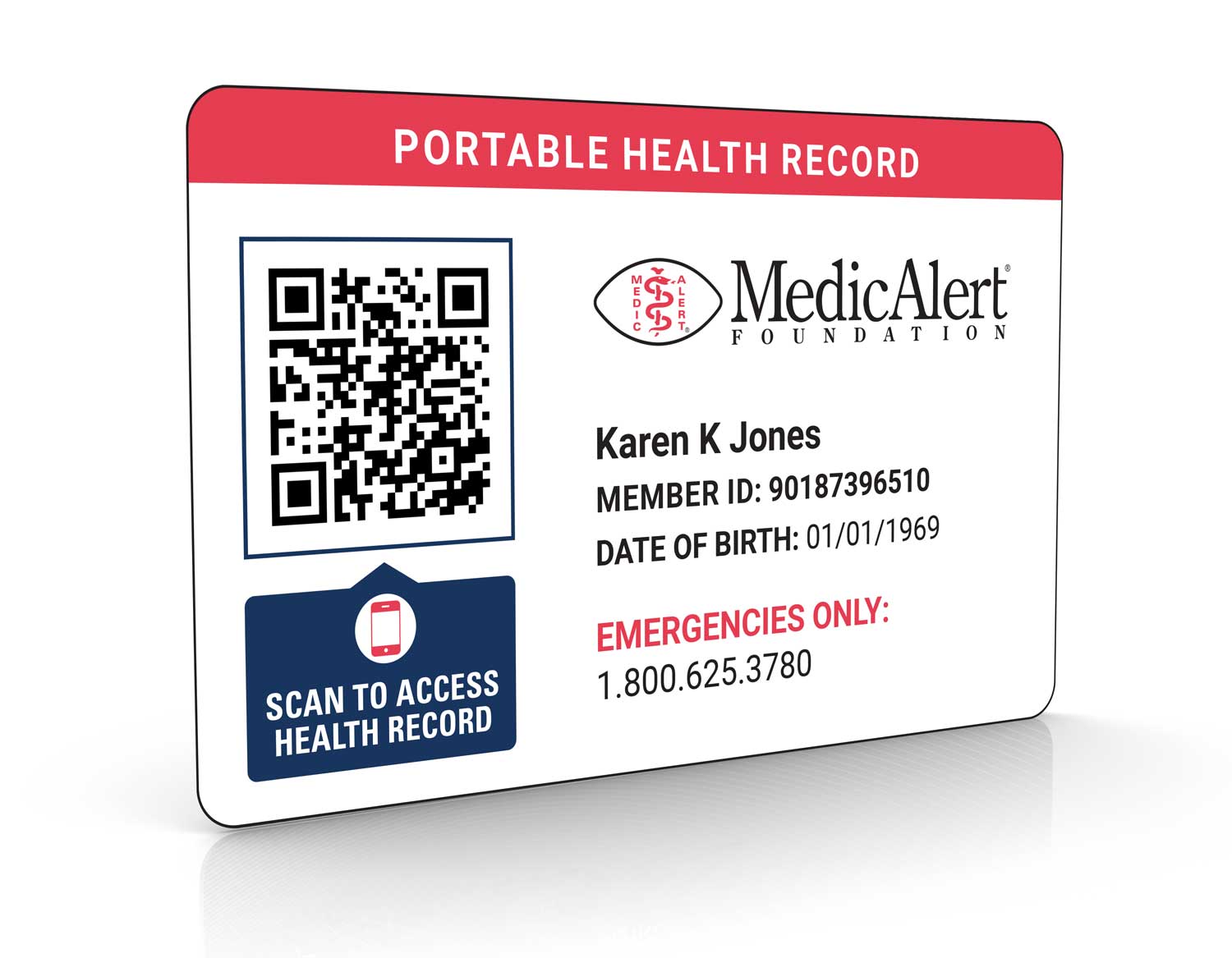Being a MedicAlert member is very worthwhile. If you have any allergies, diabetes, or just simply take any medication - you should have a MedicAlert ID. It is the best way to go. I am very happy with my MedicAlert ID and membership plan.
Linda Smethers, MedicAlert member

Medical IDs for Spinal Cord Injuries
The confidence to live with spinal cord injuries
In our day-to-day lives, we don’t have much reason to consider the role the spinal cord plays in basic functioning. Responsible for movement and sensation, the spinal cord runs from the brain through the center of the vertebral bones of the neck and back, carrying nerve signals to the rest of the body.
When a person has a spinal cord injury, there is damage to the spinal cord that causes an interruption to those nerve signals. In the U.S., the National Spinal Cord Injury Association estimates that as many as 450,000 people are living with a spinal cord injury.
Spinal cord injuries are a common cause of permanent disability and death in both children and adults. If you have a diagnosis of a spinal cord injury, there are ways that you can learn to treat and manage this injury and its complications so that you can live an active, full life.
Medical IDs for spinal cord injuries play an important role in providing extra safety for those living with this condition.
How MedicAlert protects those with spinal cord injuries
One thing you shouldn’t worry about is what could happen if there’s a medical emergency. MedicAlert’s protection plans offer benefits that extend beyond the ID, providing safety and peace of mind for people living with spinal cord injuries, their families and caregivers.

24/7 Emergency Response
Our team provides first responders the information they need to provide fast, accurate care.

Digital Health Profile
All your vital information, all in one place for you and your caregiver.

Emergency Contact Notification
In an emergency, we connect families so that no one is alone in a crisis.

24/7 Emergency Response
Our team provides first responders the information they need to provide fast, accurate care.
Pair a medical ID for spinal cord injuries with the protection plan that’s right for you.
What exactly is a spinal cord injury?
Spinal cord injuries occur when there is damage to the spinal cord, which is a column of nerves within the vertebrae (bones of the spine). This damage can interfere with sensation, movement, and other functioning below where the damage happened.
Two different categories of injuries can happen to the spinal cord: complete and incomplete injuries.
- A complete injury means there is a total loss of function below the injury. Both movement and sensation are disrupted. These account for nearly 50% of spinal cord injuries.
- An incomplete injury results in partial functioning below the injury. Half of the body may experience sensation and movement, for example.
Beyond these descriptions, spinal cord injuries are also described by type, based on the symptoms they cause. The most common types are as follows:
- Tetraplegia– also known as quadriplegia, this is the most severe type of injury, happening at the level of the cervical spine, or neck. Movement, breathing, and bowel and bladder function can all be affected.
- Paraplegia– this affects the lower half of the body including the legs, due to a spinal cord injury to the thoracic spine, or trunk.
- Triplegia– with this type of injury, movement and function of one arm and both legs is affected, usually due to an incomplete spinal cord injury.
What are the symptoms and complications of spinal cord injuries?
When a spinal cord injury occurs, some initial symptoms happen that are a sign of a medical emergency. The Mayo Clinic describes the following symptoms of spinal cord injury:
At the time of an injury:
- Trouble with balance and walking
- Loss of bowel and bladder control
- Weakness, loss of coordination, or paralysis anywhere in your body
- Difficulty breathing
- Severe pain or pressure in your back, neck, or head
- Numbness and tingling or loss of feeling in your hands, feet, fingers, or toes
- A neck or back that appears twisted or positioned oddly
General symptoms present anytime after an injury:
- Loss of movement
- Loss of sensation or altered sensation, such as difficulty feeling heat, cold, and touch
- Exaggerated reflexes, or muscle spasms
- Trouble breathing
- Coughing
- Changes in sexual function/fertility
- Loss of bowel and bladder control
- Pain/severe tingling sensations
People with spinal cord injuries can also have long-term complications because of difficulty with mobility and sensation. These include pneumonia (common in more than half of people with spinal cord injury), bedsores, chronic pain, headaches, mood and personality changes, and frequent infections.
What to engrave on MedicAlert IDs for spinal cord injuries:
MedicAlert offers free custom engraving on all our spinal cord injuries bracelets and medical ID products. The engraving on your ID should include the critical medical information that first responders need to know in an accident or emergency.
The best things to engrave on medical IDs for spinal cord injuries include:
- Medical history, including the type of spinal cord injury
- Medications
- Allergies
- Any medical devices you use, like electronic stimulators
- Any other important details for first responders to know right away

Sample engraving. Consult our team if you need help engraving your medical ID for spinal cord injuries.
How do you diagnose spinal cord injuries?
When a spinal cord injury is suspected, a thorough examination and series of tests are performed. A doctor will start with an exam and ask questions to understand the event that caused the injury.
At this stage, it is an emergency and precautions must be taken to avoid further damage to the spinal cord. A neurologist is usually involved in the process of diagnosing a spinal cord injury.
Some tests that may be done to confirm spinal cord injury include:
- X-ray (less commonly, as details are limited)
- CT scan (computerized tomography) for detailed images of bones, muscles, and more
- MRI (magnetic resonance imaging), another detailed way to see images of internal body structures including any herniated discs in the spine that could be affecting the spinal cord
How do you treat, manage, and live with spinal cord injuries?
Immediately following a serious injury that causes spinal cord damage, it is sometimes necessary to perform surgery to stabilize the part of the spine that may also be damaged. In other cases, traction to stabilize the spine as the injury heals may be the best treatment.
Unfortunately, the injury to the spinal cord itself causes permanent damage. Research is ongoing to find ways to repair spinal cord injuries, including devices that can connect with the nervous system to improve function, cell therapies including the use of stem cells, and medications that help repair nerve damage.
Treatment options that are currently available include:
- Supportive measures like a feeding tube for eating or a ventilator (breathing machine) if these functions are limited
- Counseling to support the emotional challenges that can come with this type of injury and loss of function
- Pain specialists or a palliative care team to help with chronic pain
- Rehabilitation therapies such as physical therapy (PT), occupational therapy (OT), vocational rehabilitation, and more
In addition, adaptive and assistive devices like wheelchairs, electronic stimulators, and computer-assisted technology can help overcome barriers caused by spinal cord injuries.
Treatment options used will vary between people depending on the type and severity of spinal cord injury. One strategy that can be consistent, however, is the use of a medical ID to alert first responders to your medical needs in an emergency.
MedicAlert’s custom medical IDs for spinal cord injury give you the peace of mind of knowing that every critical detail related to your spinal cord injury is easily accessible in a situation where every second counts.
How a medical ID for spinal cord injuries combined with MedicAlert Membership provides peace of mind
If you’re living with a complex medical condition like spinal cord injury, adding a medical ID to your care can help protect you in any unforeseen emergencies. A high-quality, easily recognizable ID like the ones available from MedicAlert could save your life in an emergency.
By wearing a MedicAlert ID, you ensure that first responders have quick access to important details about your medical care, including medical history and medications. This helps healthcare providers to give you the best possible care in an emergency. If you aren’t able to relay these details yourself, MedicAlert can be your voice.
-
Be your voice: If you can’t speak for yourself, your ID will speak for you, informing others about your spinal cord injuries and any medications you are taking.
-
Provide 24/7 emergency protection: Our team will relay all of your critical medical information to first responders in an emergency, no matter where or when it happens.
-
Keep you connected: You should never be alone in an emergency, that’s why MedicAlert will reach out to your emergency contacts when needed if you are unable to do so.
- Enable you to live with confidence: The freedom to live your life with spinal cord injuries, knowing that MedicAlert is there for you.
DISCLAIMER: THIS WEBSITE DOES NOT PROVIDE MEDICAL ADVICE. The information in this article is presented for educational purposes only and is not intended as a substitute for professional medical advice, diagnosis and treatment. Always seek the advice of a physician or other qualified healthcare provider for any questions you may have regarding a medical condition or treatment.







